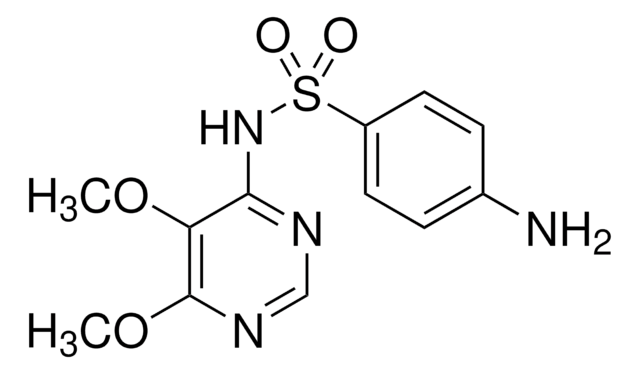S9882
Sulfachloropyridazine
Synonyme(s) :
4-Amino-N-(6-chloro-3-pyridazinyl)benzenesulfonamide, N1-(6-Chloro-3-pyridazinyl)sulfanilamide
About This Item
Produits recommandés
Forme
powder
Couleur
off-white to light yellow
Solubilité
0.5 M NaOH: soluble 50 mg/mL
Spectre d'activité de l'antibiotique
Gram-negative bacteria
Gram-positive bacteria
mycoplasma
Mode d’action
DNA synthesis | interferes
Chaîne SMILES
Nc1ccc(cc1)S(=O)(=O)Nc2ccc(Cl)nn2
InChI
1S/C10H9ClN4O2S/c11-9-5-6-10(14-13-9)15-18(16,17)8-3-1-7(12)2-4-8/h1-6H,12H2,(H,14,15)
Clé InChI
XOXHILFPRYWFOD-UHFFFAOYSA-N
Vous recherchez des produits similaires ? Visite Guide de comparaison des produits
Application
Actions biochimiques/physiologiques
Autres remarques
Mention d'avertissement
Warning
Mentions de danger
Conseils de prudence
Classification des risques
Skin Sens. 1
Code de la classe de stockage
13 - Non Combustible Solids
Classe de danger pour l'eau (WGK)
WGK 3
Point d'éclair (°F)
Not applicable
Point d'éclair (°C)
Not applicable
Équipement de protection individuelle
dust mask type N95 (US), Eyeshields, Faceshields, Gloves
Faites votre choix parmi les versions les plus récentes :
Déjà en possession de ce produit ?
Retrouvez la documentation relative aux produits que vous avez récemment achetés dans la Bibliothèque de documents.
Les clients ont également consulté
Active Filters
Notre équipe de scientifiques dispose d'une expérience dans tous les secteurs de la recherche, notamment en sciences de la vie, science des matériaux, synthèse chimique, chromatographie, analyse et dans de nombreux autres domaines..
Contacter notre Service technique









